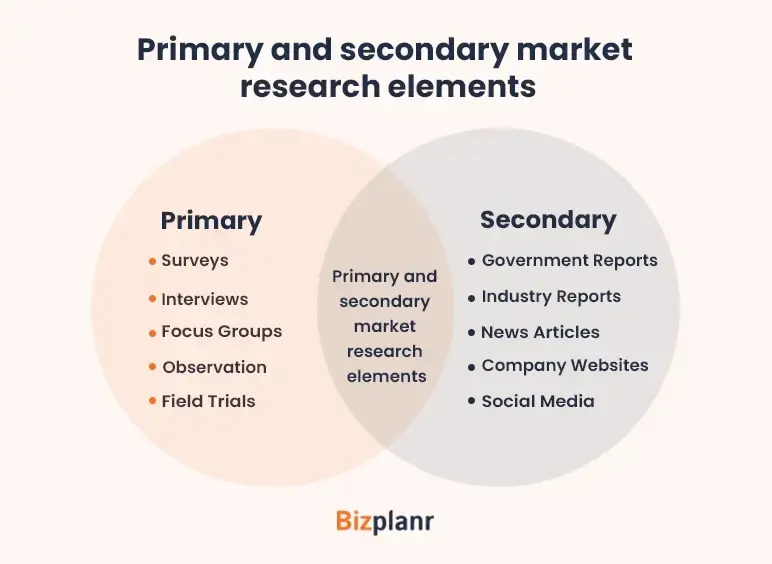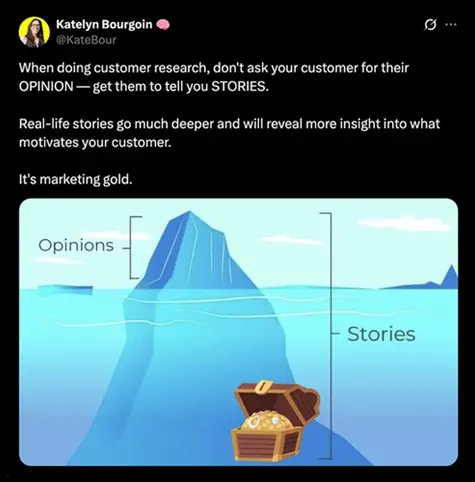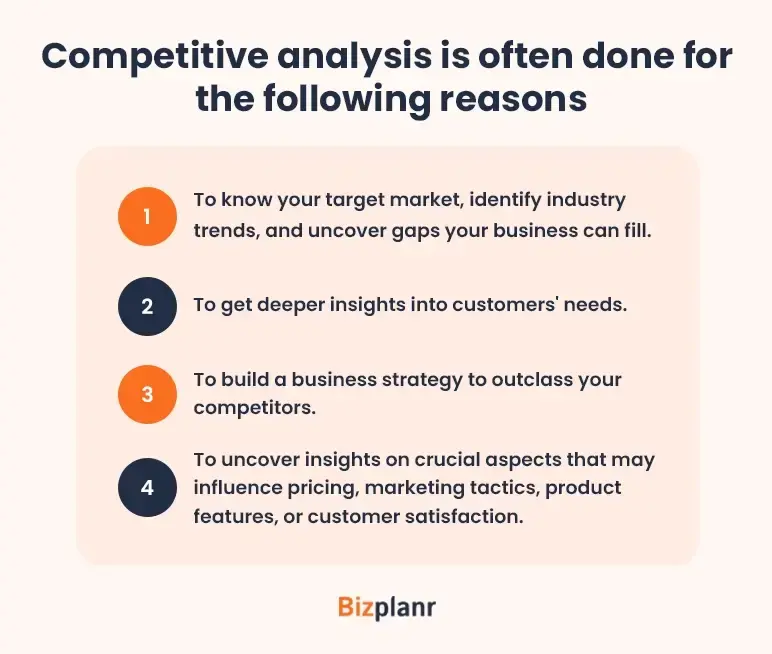In modern business, success isn’t just about having good capital and a solid strategy. Many businesses, despite limited resources, dominate the market through the power of data. But where does this data come from? The answer is market research.
By conducting the right market analysis or research, businesses gain valuable insights that help them navigate challenges and outsmart competitors.
But when should you use market research, and how can it make a difference? Don’t worry—this blog will guide you through various types of market research, showing you exactly when and how to use them to drive your business toward success.
Let’s get started.
10+ Types of market research
Market research is all about gathering, analyzing, and interpreting information about a market that helps you identify growth opportunities.
But how to do market research? Here are 10+ market research types that can provide valuable insights, helping you make informed decisions that drive business growth and minimize risks.
1) Primary research
| What it is | Getting new info straight from people by asking or watching them |
| Best for | New products, customer feedback, niche or specific market insights |
| Cost | Medium to high |
| Time | Usually 1-4 weeks |
| Research methods | Directly from people (customers, users, etc.) |
Primary market research is collecting fresh or original data directly from your target audience. It’s when you go out and get information straight from prospective customers yourself.
For example, ask your friends what kind of video games they love playing, or ask people to try your product and share their honest feedback.
This marketing research is used to get real, fresh, and accurate information that’s tailored just for your product, service, or idea. It’s used when you don’t want to rely on outdated info or general stats; you want your people’s thoughts, opinions, and behaviors.
Here’s how you can gather data from this market research:
- Surveys – Ask people questions through forms (online or in person)
- Interviews – Talk one-on-one with someone and dig deep
- Focus groups – Bring a small group together and chat about the topic
- Product testing – Let them try your product and tell you what works and what flops
2) Secondary research
| What It Is | Using info that's already out there, like books or websites, to learn stuff |
| Best for | Understanding the market trends, checking out competitors, and getting deeper insights |
| Cost | Zero to low |
| Time | A few hours to a couple of weeks |
| Research methods | Government statistics & reports, public domain data, industry websites, research papers, and news articles |
Secondary research is using existing information instead of collecting new data yourself. Think of it as reading news articles, industry reports, or checking stats online that someone else has already gathered and published. You’re not doing the digging; instead, you’re just reading what others found.
The objective of secondary research is to understand the big picture using data that already exists. You may take the help of a market research template; it helps you spot trends, study competitors, and explore market size without spending too much time or money.
Here are a few more elements to get started with secondary research:
- Google it: Search online for articles, blogs, or news about what you’re curious about. For example, “What snacks are popular with teens?” if you’re willing to open a cafe for teens.
- Hit the library: Check out books, magazines, or industry reports. Libraries are like treasure chests for this stuff.
- Look at stats: Find numbers from websites like government sites or big companies that share data, like how many people buy ice cream in the summer.
- Read studies: Some smart folks write reports about markets, like how much people spend on video games. You just grab those and read up.
3) Qualitative research
| What it is | Research people's thoughts, feelings, and reasons behind what they do. |
| Best for | Exploring why people think or behave a certain way |
| Cost | Medium |
| Time | 1-6 weeks |
| Research methods | Interviews, focus groups, or watching their behavior |
Qualitative research is all about getting into people’s heads to understand their feelings, opinions, and reasons for stuff.
Remember, it’s not about counting how many like it—it’s about why they do.
For example, if you’re selling cookies, qualitative research helps you learn why some kids pick chocolate chip over oatmeal, straight from what they tell you.
Here’s a simple process to conduct qualitative research:
- Interviews: Sit down with someone and ask them open questions, like, “What do you love about your favorite game?” You let them talk, and you take notes.
- Focus groups: Get a small group of 6-8 people and have them chat about something, like what makes a great toy. You guide the talk and listen for cool insights.
- Observations: Watch people in action, for example, seeing how kids play with toys at a store, and note what they seem to enjoy most.
- Open-ended surveys: Ask questions where people write their thoughts, like, “What would make your ideal pizza?”
4) Quantitative research
| What it is | Research that focuses on numbers, stats, and measurable data |
| Best for | Measuring things, like how popular something is or what most people choose |
| Cost | Medium to high |
| Time | 1-8 weeks |
| Research methods | Online surveys, polls, questionnaires, website/app analytics |
This type of research is all about numbers, statistics, and measurable data. For example, measuring how many kids at school love pizza versus tacos.
The main goal of quantitative research is to measure how many people like something, how often they buy it, and what percentage of users prefer option A over B. It helps you test ideas, validate assumptions, and make data-driven decisions.
To get started with quantitative research, try out the following tactics:
- Surveys with numbers: You ask questions where people pick specific answers, such as rating a toy from 1 to 5 or choosing “yes” or “no.” You can send these out online, hand them out in person, or even mail them.
- Polls: Quantitative data includes quick questions to a bunch of people, for example, “What’s your favorite ice cream flavor?” Then you add up everyone’s answers.
- Tracking data: You check out numbers that are already out there, such as how many bikes a store sold last month or how many clicks your website gets daily.
- Experiments: You test something out, say, offering your lemonade at two different prices and counting which one sells more.
5) Exploratory research
| What it is | Investigating new ideas or problems to get a sense of what's going on |
| Best for | Starting a project when you're not sure what questions to ask yet |
| Cost | Low to medium |
| Time | 1-4 weeks |
| Research methods | People's opinions, existing reports, online discussions, or expert insights |
It’s the kind of research you do when you don’t even know the real question. You’re just exploring an idea, a market, or a problem, trying to understand what’s out there and where you should dig deeper. Remember, there’s no pressure to get exact answers; you're just gathering clues.
Among other market research methods, exploratory research is unique as its purpose is to discover data-driven insights by uncovering unknown problems.
Here’s how you can gather insights with this market research:
- Chatting with people: Have casual talks with a few folks, such as asking kids what they wish snacks tasted like or what games they play.
- Reading up: Look at articles, blogs, or social media posts to see what’s trending. Maybe check out what parents say about kids’ toys in online forums.
- Focus groups: Get a small group together to brainstorm, for instance, asking a handful of kids what would make a toy super fun.
- Observing: Watch what’s happening, such as noticing what catches people’s eye in a store or what they’re excited about at a fair.
6) Descriptive research
| What It Is | Research that describes characteristics, behaviors, and patterns in detail |
| Best for | Understanding who your audience is, your target market, what they do, and how they behave |
| Cost | Medium to high |
| Time | 2-8 weeks |
| Research methods | Surveys, sales records, customer data, or observations of specific groups |
Similar to primary research, descriptive research collects fresh data directly from your audience. But instead of exploring or testing, it focuses on clearly showing the “what,” like customer preferences, habits, or behaviors in a structured and measurable way.
It helps you get a deeper understanding of current situations, like taking a photo of a situation, showing things like how many people buy certain snacks, who they are, or where they shop.
For example, if you’re thinking about selling cookies, descriptive research might tell you that 60% of kids buy chocolate chip cookies after lunch on Fridays.
The purpose of this market research is to gather information on the situation clearly so you know exactly what’s up.
Descriptive research answers questions like “Who’s buying my product?” “How often?” or “Where are they shopping?” If you’re planning a new juice stand, it might show you that most customers are teens who stop by after school.
Such a data-driven approach will be super useful for deciding when to open or what flavors to stock.
To conduct market research using a descriptive strategy, follow the mentioned steps:
- Surveys: You ask specific questions to a bunch of people, such as “What snacks do you buy weekly?” or “How much do you spend?” These can be online, in person, or even on paper.
- Observations: You watch what’s happening, for instance, counting how many people pick one candy over another at a store.
- Checking records: You look at data that’s already there, such as sales numbers from a shop or website visits, to see what’s popular.
- Questionnaires: Send out forms asking about habits, such as how often parents buy toys for their kids or what brands they choose.
7) Product research
| What It Is | The research focused on products to see if people like them, want them, or how they can be better. |
| Best for | Testing new ideas, improving products, or deciding what features to add. |
| Cost | Medium to high |
| Time | 2-12 weeks |
| Research methods | One-on-one interviews, focus groups, prototypes, online surveys, and beta testing |
Product research is when you study how a product performs, what people think about it, and if it solves a real problem. You can do this for valuable insights on a product idea you’re thinking of launching or for one that’s already out there but needs improvement.
The product research objectives are to make sure your product hits the mark. It helps you understand things like:
- What features matter most to customers
- What problems the product should solve
- How users interact with it
- If it’s better or worse than competitors’ products
Here are some common ways we can do product research:
- Surveys & interviews – Ask people what they want or don’t like
- Prototype testing – Give people a basic version and see how they use it
- Focus groups – Sit a few people down and discuss ideas or experiences
- Competitor analysis – See what others are offering and how customers feel about it
- Beta testing – Release your product to a small group first and gather feedback
8) Customer research
| What It Is | Learning about your target audience–Who they are, what they want, and how they act. |
| Best for | To collect detailed insights on target customers' needs, improve customer experience, and tailor marketing |
| Cost | Low to medium |
| Time | 1-6 months |
| Research methods | Online surveys, in-depth interviews, feedback forms, social media, and historical trends |
Customer or consumer research is when you dig deep to understand who your customers are, what they need, how they think, and why they buy. It’s all about stepping into their shoes so you can serve them better.
Consumer research isn’t just guessing what they want—you’re asking, listening, and learning from them directly. The purpose of consumer research is to get valuable insights to make better business decisions that connect with your customers.
There are a bunch of ways to do it, depending on how deep you want to go:
- Surveys: Ask customers questions, such as “What do you love about our snacks?” or “How often do you shop here?” You can send these online, hand them out, or ask in person.
- Interviews: Have one-on-one chats with customers to hear their stories, maybe asking a mom why she picks certain toys for her kids.
- Watching behavior: Observe what customers do, such as noticing which products they grab first in a store or what they click on your website.
- Checking data: Look at numerical data, like how many people buy your stuff, what they spend, or what they say in reviews online.
9) Observational research
| What It Is | Watching customer behavior in real-time without directly interacting |
| Best for | Seeing real behaviors, like how people shop or use products in real life. |
| Cost | Low to medium |
| Time | 1 day to 4 weeks |
| Research methods | Live observations, video recordings, people’s movements, and user session replays |
Observational research is when you watch how people behave instead of asking them what they do. It’s like being a ninja, noticing how people act, what they pick, or how they move around.
For example, if you’re thinking about selling ice cream, you might watch to see if people go for cones or cups and what flavors they choose most.
Such research is often done in places where customer actions can speak louder than their words, like retail stores, restaurants, supermarkets, or even on websites and apps.
Here’s how you go about it:
- In-person watching: Go to a place, like a mall, and note what people do—maybe how long they spend looking at candy or which snacks they grab.
- Video recordings: Set up a camera (with permission!) to capture how people move through a store or use a product, then review the footage.
- Online tracking: Check how people browse a website, such as which buttons they click or how long they stay on a page.
- Field notes: Follow people in a natural setting, like watching kids at a park to see what games they play most, and jot down what you see.
The purpose of this research is to provide data-driven insights by closely observing how people behave in real-world settings. Moreover, it provides a competitive advantage by uncovering patterns, preferences, and behaviors that traditional surveys might miss.
10) Experimental research
| What It Is | A research method where you test variables in a controlled setting to see cause and effect. |
| Best for | Testing new ideas, pricing strategies, product changes, or marketing tactics. |
| Cost | Moderate to high |
| Time | 2-12 weeks |
| Research methods | Collected through experiments, A/B tests, field trials, or lab settings. |
Let’s understand this experimental market research with an example:
Imagine you're baking cookies, and you want to find out if adding more chocolate chips makes people like them more.
So, you bake two batches—one with regular chips and one with extra—and let people try both. Most people preferred the extra chips, so you decide to go with that. That’s experimental research. You’re testing one change to see if it makes a difference.
The whole point is to find cause and effect—if you change one thing, will it change the result? Like tweaking your pricing, packaging, or website layout to see what gets more sales or clicks.
Such market research is often practiced to get a competitive edge by understanding what works best and making data-backed decisions to outperform competitors.
Here’s how you do it:
- A/B testing: Try two versions of something, such as showing half your customers a red logo and half a blue one, then tracking which gets more clicks or sales.
- Field experiments: Set up a test in the target market, maybe selling your cookies with two different flavors at a fair and counting which sells out faster.
- Lab-style tests: Bring people into a controlled setting, like letting kids play with two versions of a game to see which they enjoy more.
- Tracking changes: Change one thing, like offering a discount, and measure how it affects what people do, such as how many buy your product.
11) Competitive research
| What It Is | Studying other businesses to see what they’re doing and how you can do better. |
| Best for | Brand research, identifying market gaps, improving positioning, and data collection |
| Cost | Low to moderate |
| Time | 1 to 4 weeks |
| Research methods | Public reports, websites, research centers, customer reviews, social media, and tools like SimilarWeb or SEMrush. |
Competitive research is when you study your competitors. What they’re doing right, their gaps, what customers are saying about them, and how they’re showing up in the market.
The goal here’s simple: To gain a competitive edge. You want to know what’s working for others so you can do it better—or differently. It helps you spot gaps, avoid their mistakes, and position your business smartly to stay ahead of the competition.
Competitive analysis is often done for the following reasons:
Follow these simple steps to conduct competitors' research:
- Check their websites: Look at what your competitors offer, like their prices, products, or special deals, to see what’s working for them.
- Read reviews: See what customers say online about other businesses, such as what they love or hate about a rival’s snacks.
- Watch their ads: Notice how they talk to customers, maybe spotting a fun commercial or a social media post that gets tons of attention.
- Shop secretly: Act like a customer—visit their store or try their product—to see what the experience is really like.
The bottom line
Done and dusted! In this blog, we covered 11 different types of market research that will help you understand people, test ideas, and make smart choices for whatever you’re dreaming up.
If you’re still unsure as to which market research type to opt for or where to begin, you can always hire expert help, like business planners, since it’s part of business planning.
If you don’t have the budget, you can always use a business plan generator like Bizplanr to help you create a business plan, including market research!
Start your market research today!
Frequently Asked Questions
What are the main types of market research?
The main types of market research methods include:
- Primary research
- Secondary market research
- Quantitative market research
- Qualitative market research
- Experimental market research
Each helps in data collection and provides valuable insights to make informed decisions.
What is the difference between primary and secondary market research?
Primary research gathers fresh data directly from people, while secondary market research uses existing data, like reports or studies, to save time and cost.
Which type of market research is best for launching a new product?
Primary research is your best type of market research, as it helps test ideas directly with your target audience and shape solid marketing strategies based on real feedback.
When should a business use observational research?
Use it when you want to understand customer behavior in real time without asking questions—it’s great for providing valuable insights through natural observation.
What are the 5 primary market research methods?
Surveys, interviews, focus groups, product testing, and observation are the 5 primary research methods used for accurate data collection and deep insights.










